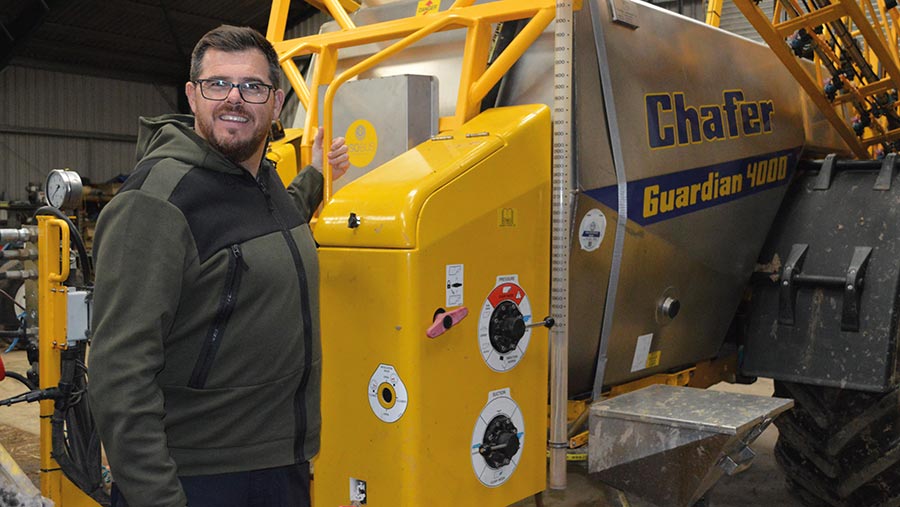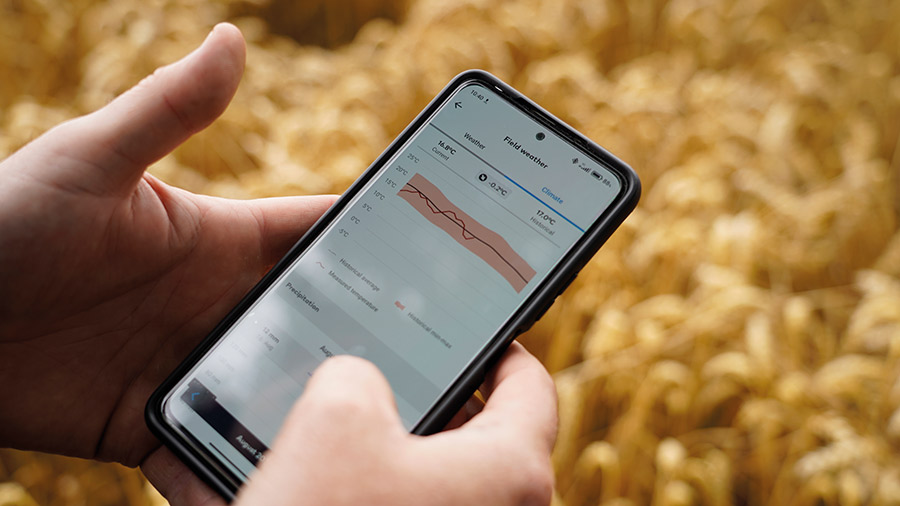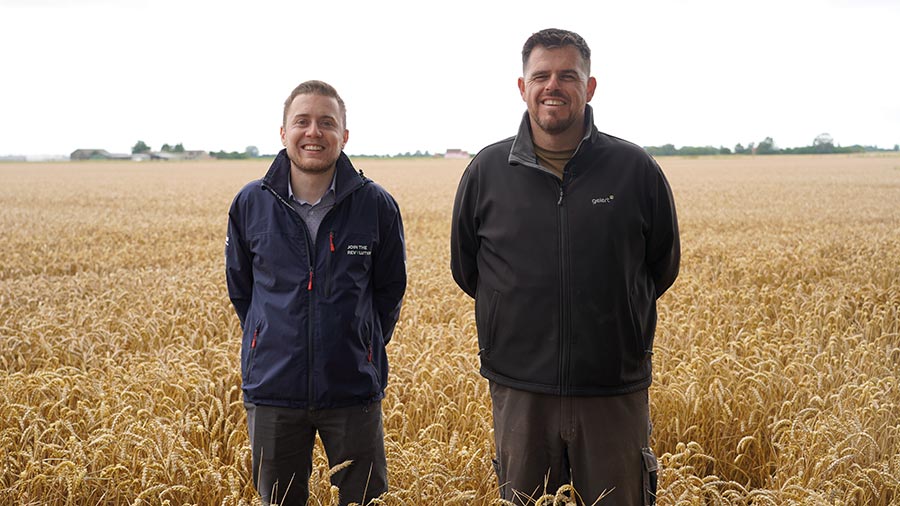Norfolk wheat grower turns digital for nitrogen benefits
 David Hurn © MAG/David Jones
David Hurn © MAG/David Jones David Hurn is using digital mapping on his farm in north-west Norfolk to squeeze out the most effective use of nitrogen fertiliser and seed to give him average feed winter wheat yields of 11t/ha with modest levels of nitrogen.
He is not cutting back on nitrogen or on seed, but using these expensive inputs more efficiently to benefit his financial bottom line and also the environment, using only 190kg/ha of nitrogen on second and third wheats on his medium to heavy silty soils.
His yield variations are getting smaller within fields on his medium-sized arable farm, as he matches input levels accurately to soil fertility, with seed rates within some fields showing a 50% difference in the most extreme cases.
“We were keen to understand the farm better on a field level, then on a hectare level, to understand where we can push crops harder,” he tells Farmers Weekly.
See also: Norfolk farmer goes digital to get spray timing spot on
Digital tools

© BASF
Mr Hurn moved to precision farming in 2014 as he started using variable rates of phosphate and potash, and adopting RTK autosteer on tractors.
He then started looking at digital tools to help him grow better crops of winter wheat, spring barley, spring beans and sugar beet.
He chose the Xarvio field manager system from BASF in spring 2020 as he saw it as easy to set up and well suited to the 166ha of arable land he farms at Eastgate Farm, as E & M Hurn, in Terrington St Clement.
After the very wet autumn of 2019, there was very little winter wheat drilled and what was sown was poorly established.
However, that proved an excellent test to use the system’s biomass maps on one field to help even out the crop throughout the season and produce a 9.5t/ha crop of wheat from the biscuit-making variety Barrel with 240-250kg/ha of nitrogen.
For the next season, variable rates of nitrogen and seed were used across 120ha of Firefly and Barrel, yielding a similar 9.5t/ha.
This was considered a good yield after the very dull weather in the grain-filling month of June resulting in disappointing specific weights, and Firefly – as a Cougar-related variety – showing a breakdown in resistance to septoria.
“The yield variations in field were getting smaller, so it was not 8t/ha here and then 12t/ha in other areas,” he says.
Focus on feed wheats
For the harvest 2022, there was a switch to feed wheats, while nitrogen levels were pulled back after the sharp rises in fertiliser prices in the middle of 2021.
The 126ha of wheat grown of varieties Gleam, Dawsum and Skyscraper saw 210kg/ha of nitrogen used for second and third wheats, and 190kg/ha for first wheat after sugar beet.
Mr Hurn tested the crops at the flag-leaf stage with an N-sensor device and found the optimum nitrogen level should be 210-220kg/ha on a third wheat.
He knew his nitrogen regime was on the right track and this resulted in the good average wheat yield of 11t/ha.
His liquid urea nitrogen regime uses a three-way split, with the first in late February/early March using a flat rate of 60kg/ha.
This is because the satellite imagery often shows patchy crops coming out of winter, and is not considered accurate enough to base applications of fertiliser.
However, the second application in mid-late March does use variable rate nitrogen (at an average rate of 80kg/ha), with more nitrogen applied to parts of the crop with low biomass to encourage tillering, and a lower rate on high biomass areas to even the crop out.
The third application is again at a variable rate (at an average rate of 70kg/ha) and delivered in mid-April.
But the variable rate dose ratio is reversed as tillering is coming to an end, and so less is applied to the lower biomass and more to feed to better areas of the field.
“Variable nitrogen is a good tool, but it needs to be linked to variable seed applications to get the best results,” he says.
Variable seed rates
He uses a base seed rate of 180kg/ha for his wheat, but this can vary from 160 to 240kg/ha, with poor areas of the field receiving more seed, and the more fertile areas less seed to give an even crop.
Again, he emphasises he is not looking to cut costs, as with nitrogen, but increase the profit margin a hectare.
The digital system is also proving useful in his move towards applying for the new Sustainable Farming Incentive (SFI) to replace direct farm subsidies, where, with advice from his independent agronomy adviser Steve Baldock at Prime Agriculture, he is trying out cover crops for the first time and recording them on his digital platforms.
His cover crops are being established using a seed hopper on top of his Sumo Trio cultivator, which is used across all cereal land post-harvest with the straw all chopped.
The cost of the cover crop seed is £28/ha to apply for the medium tier of the SFI arable soil scheme, paying out £40/ha across the whole farm.
All his 66ha of land destined for spring cropping is growing cover crops to try and improve organic matter levels, which on his silty soils are inherently low due to the low clay content.
“In the medium to long term, we need to improve soil health, and the easiest way is by using cover crops,” he says.
Mr Hurn is also using digestate, applied post-harvest, which is high in phosphate, with some sulphur and nitrogen, and this is helping with early rooting and may lead to a reduction in nitrogen in the spring of about 30kg/ha.
The digital system also helps him make records for his 5.25ha of land under a Countryside Stewardship scheme, using AB1-nectar flower mixes, AB9-winter bird food, SW1-buffer strips and SW4-watercourse buffer strips.
Three levels

Luke Pollard and David Hurn © BASF
Mr Hurn is using the variable rate top tier of the Xarvio system, but Luke Pollard, the Xarvio implementation lead, explains there are three levels of the system available to farmers:
- Basic – free for all features for just two fields
- Application timer – £340/year/farm
- Variable rate (includes application timer) –- £600/year/farm
The application timer (included in the top tier variable rate tier) helps predict a crop’s growth stage and the risk of disease, based on such factors such as drilling date, variety, soil type and weather, to tailor a spray application at the best timing.
Mr Hurn, who adds in data from his own on-farm weather station, sees the digital data as giving a very accurate forecast of when to spray and could be useful in very dry springs when many growers looked to delay T1 fungicide sprays due to a low disease threat.
“I found the predictor of growth stages to be very accurate, and with this good tool we may be able to delay applications to give more protection later on,” he says.

